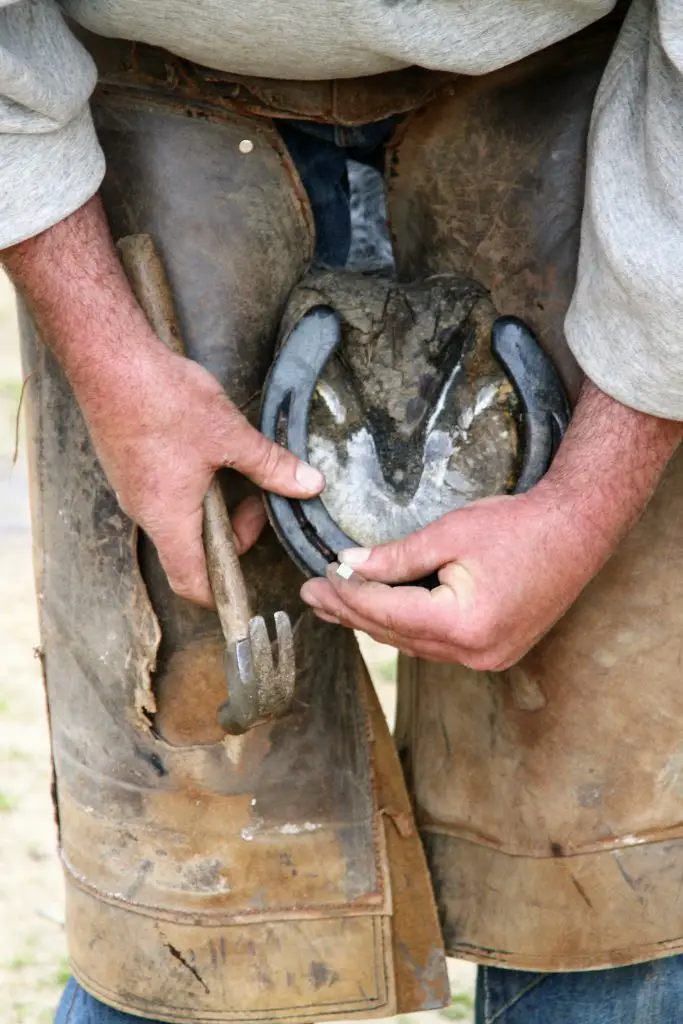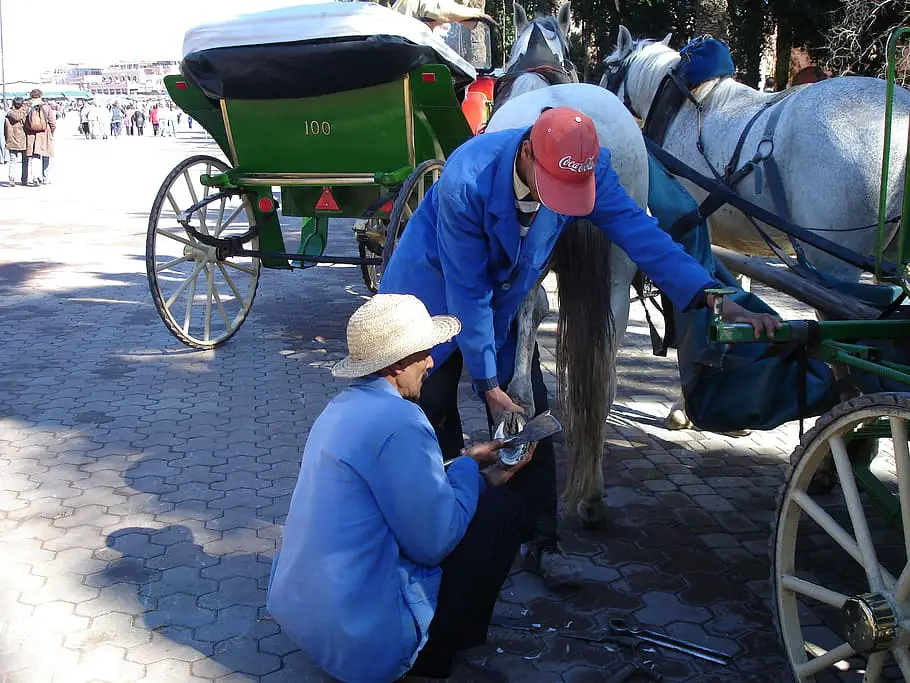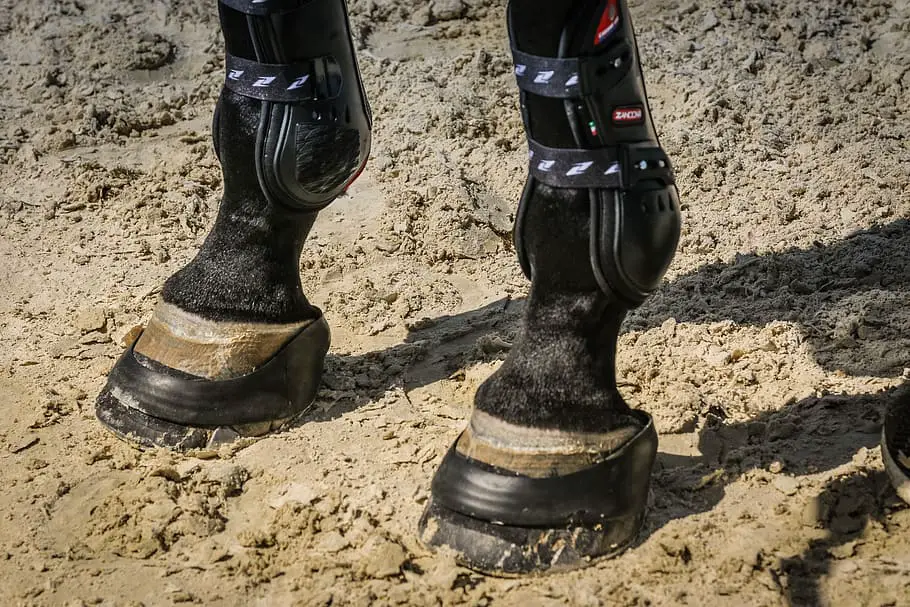Last Updated on July 13, 2020 by Allison Price
Most horses can live their lives barefoot. But as horse parents, we would be at ease if we give them shoes to wear!
Horseshoes protect horses’ hooves just like shoes protect our feet.
But one of our concerns is the cost. How much does a horse shoe cost?
You can buy a set of horseshoes. Good news! Isn’t it?! You can’t go wrong on buying a St. Pierre American Professional Horseshoes Set which costs $45 for a set of two pairs. It is made of high strength steel which makes it great for a backyard set.
Does My Horse Need Shoes?
Deciding whether your horse needs shoes should come down to these factors:
Protection
Think of the environment where your horse lives and works. Yes, it can impact the necessity for shoes. Hard, stony ground can cause soreness or bruising.
When conditions are only temporarily unsuitable, you may use alternative solutions. Hoof boots like Hoof Overreach Bell Boot protect your barefoot horse. Not only does it protect, it also provides traction. It is generally safe for all disciplines. Plus, it’s easy to clean even when muddy or poopy.

Performance
Your horse may need shoes to optimize performance. But it depends in what event you’re using your horse for.
If your horse works in snowy and icy conditions, he typically needs snowball pads. They keep snow from balling up on the bottom of the feet.
Some horses have jobs that increase the concussion on the foot. Like as high-level jumpers and eventers. They will do well with shoes for increased support. Unlike dressage horses, who often perform on groomed arena footing. They are unlikely to encounter stones that could cause foot soreness… and decreased performance. Event horses perform on many types of surfaces with varying quality of footing. They often need the added protection and traction of shoes.
Medical Conditions
Some horses have naturally strong and healthy feet. They can go without shoes in many situations. But others need extra support and won’t enjoy being barefoot.
Horses with arthritis or a disease like laminitis need shoes.
A healthy sole is strong and hard. While a weak sole is thin and pliable. If your horse has weak soles, it will be an advantage to wear shoes. It protects your horse’s sole and save you from shelling out money for medical treatments.
How Often Should You Re-Shoe Your Horse?
It’s important to know the signs of re-shoeing or resetting your horse.
Here are the following signs you can look for:
- Loose nails that push up from the wall of the hoof
- Nails that protrude further out of the shoe on the underside
- Shoes become loose or come off altogether
- The hoof is starting to overgrow the shoe. It’s getting out of shape
- Shoes have become excessively thin or unevenly worn
- The shoe is twisted on the foot
Although we have these signs to look for, it’s not a good idea to wait until you notice one of these things. Most of these signs show that the shoes have been on too long.
Generally, six weeks is a guideline for good hoof health. It is also about time that a barefoot horse should be trimmed. Some horses may need to be reset sooner. And some can go a little longer. It is best to consult your farrier still to determine when a reset is due.
Warning: Don’t leave shoes on for months. It can damage the hoof. And overgrown hooves can lead to soft tissue damage.
Re-Shoeing Process
When the shoes are reset, the farrier will:
- Pull the shoes off
- Trim the hoof growth off
- Shape the hoof
- Nail the same shoes back on
Shoes can be reset if there is no excessive wear to the metal. It depends on the type of terrain you have been riding on. Shoes may only last through one or two resets if you ride over an abrasive surface like rocks. But they may last for months if your horse walks most of the time on grass.
Once the shoes start to thin, put on the new set. The initial shoeing might cost more than a reset.
Do Horse Shoes Hurt Your Horse?
You may be concerned that applying and removing their shoes will be painful for them. Because the horse shoes are attached directly to the hooves. I can totally understand how you feel.
But this is a completely pain-free process. Because the tough part of a horses’ hoof does not contain any nerve endings. They don’t show any signs of pain or aggression. They will feel a similar sensation to the feeling that we get when our fingernails are trimmed.
Dangers of Horseshoeing

Barefoot enthusiast point shoeing as the cause of many problems. Indeed, poor shoeing can do more harm than good.
But shoeing has many benefits as well. It’s up to you to discern whether barefoot is the best for your horse or not. Most farriers are good at their jobs. But mistakes happen. If the horse’s hoof is brittle or damaged, the nails used in horseshoeing can damage the hoof more. If the nails are inserted incorrectly, it can cause a pain on your horse. An improperly placed or fitted shoe can cause damage when your horse walks. It is like the tissues that arise when humans wear shoes that are too small for them.
Takeaway
For pleasure horses, shoes are not really necessary. Sensible maintenance including regular trimming may be all that is needed. But pay attention to the wear of the hoof and the comfort of your horse as you ride over all sorts of footing. If your horse is getting sore feet, consider some several options. Your horse may need a protection life hoof boot. Or you may opt for traditional nailed on shoes. There are also glued on shoes. And you can also buy a set of two pairs. Still, the best resource for information about what hoof protection is your farrier.
Bare-footing is considered the ideal for horses. But there are times when shoes are necessary. If your horse pulls an abnormal amount of weight, he may need shoes to prevent his hooves from wearing down. If your horse is for racing, shoes protect them if they have weak hoof or leg muscles.



